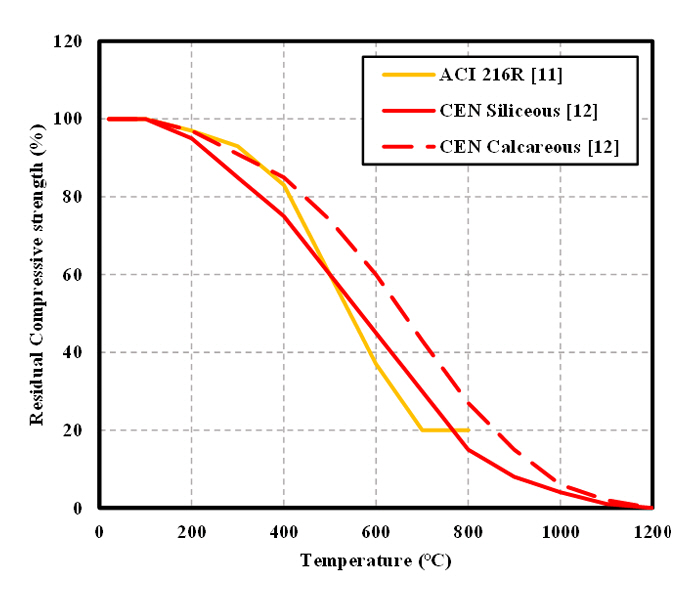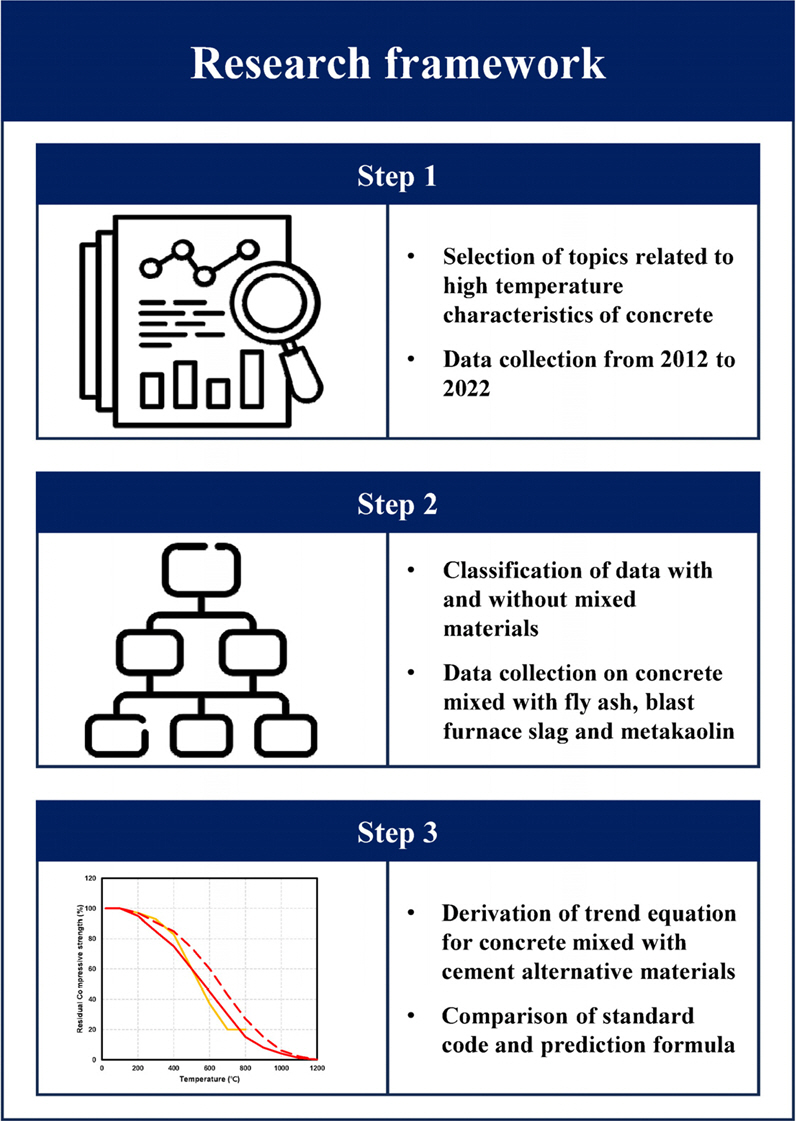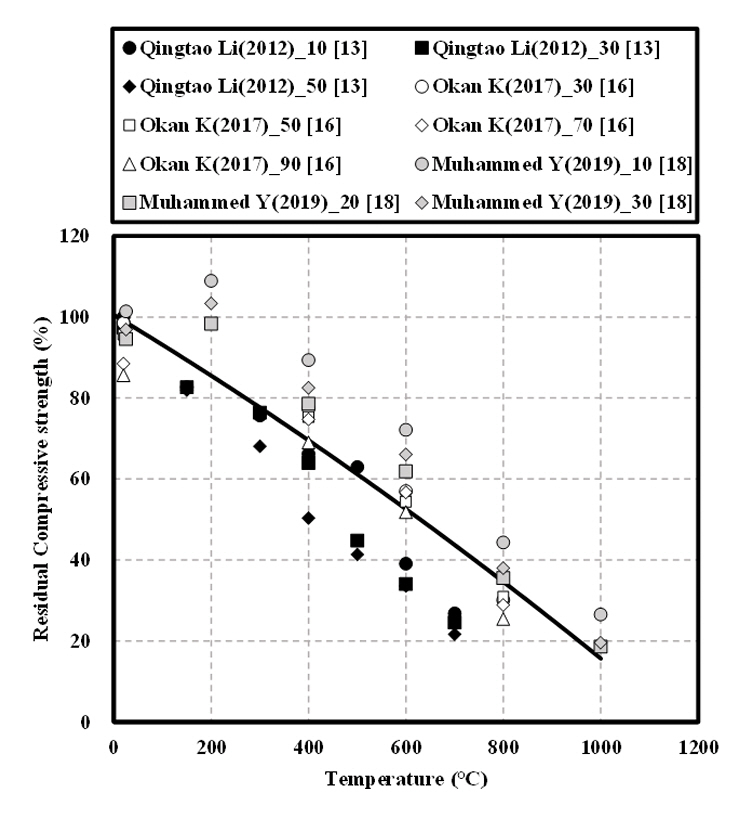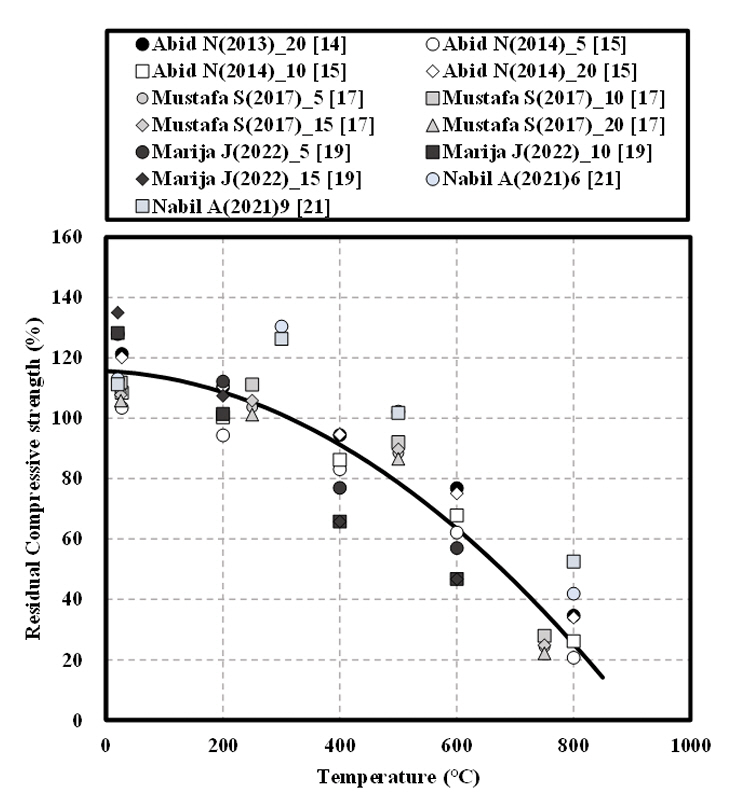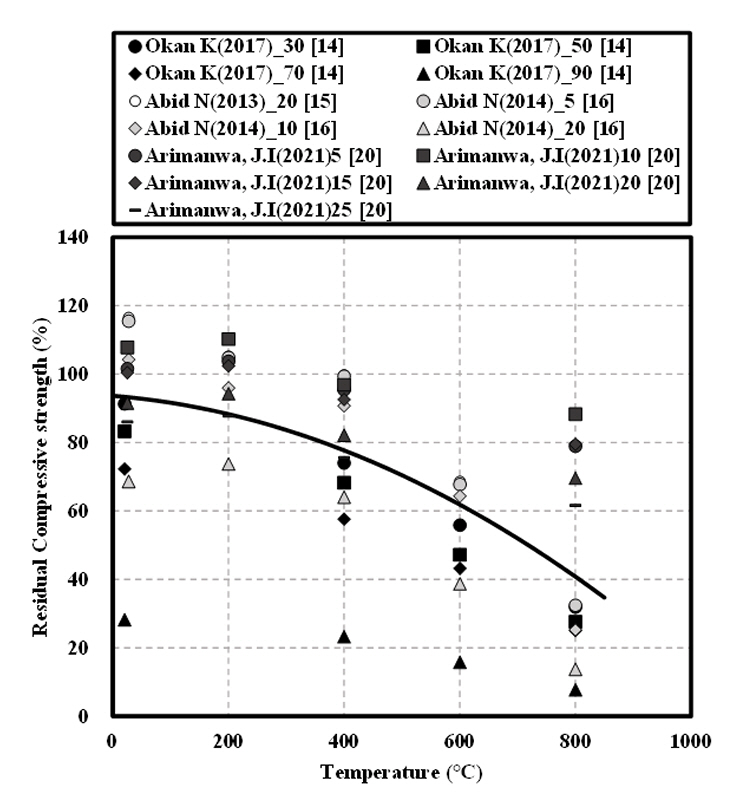 |
 |
- Search
| Int J Fire Sci Eng > Volume 37(4); 2023 > Article |
|
Abstract
In this study, we analyzed results reported in existing literature to examine the residual mechanical properties of concrete mixed with different admixtures. Ground granulated blast furnace slag (GGBFS), fly ash (FA), and metakaolin (MK) were selected as admixtures for analysis, and data reporting the residual compressive strength of concrete with different admixtures at high temperatures were analyzed. Then, with reference to the ordinary Portland cement (OPC) using 100% cement, prediction formulas for the residual mechanical properties of concrete were derived for each selected admixture, and the resulting values were compared with the values of codes used in international concrete specifications. The residual mechanical properties of concrete showed different results depending on the admixtures used, and the concrete mixed with MK showed a higher compressive strength than OPC at room temperature compared with the values of the existing codes. With increasing temperature of concrete exposure, the trend of compressive strength showed convergence to the values of the existing codes. At room temperature, concrete mixed with GGBFS or FA showed a trend of similar or lower compressive strength compared with that of the existing codes; however, with increasing temperature, the residual compressive strength exceeded that of American Concrete Institute (ACI) and CEN codes. Thus, at room temperature, concrete mixed with MK had excellent compressive strength, but with increasing temperature, concrete mixed with FA or GGBFS was observed to exhibit superior residual mechanical properties.
When subjected to high temperatures, concrete is known to be one of the most fire-resistant materials available in the construction industry, and it is also classified as a noncombustible material. However, long-time exposure to high temperatures causes changes in the chemical composition and physical properties of concrete. As concrete is a composite material, among the components of concrete, when cement paste, functioning as an adhesive of aggregate, is exposed to high temperatures, its performance as an adhesive in relation to the aggregate deteriorates and cracks are formed[1,2]. Mucteba U[3] reported that, when concrete is exposed to high temperatures, cement paste shows the following changes with increasing temperature: the expulsion of evaporable water at 100 Ōäā, the dehydration of the hydrates of calcium silicate at 180 ┬░C, the decomposition of calcium hydroxide at 500 Ōäā, and the decomposition of calcium silicate at approximately 700 ┬░C. Owing to the alterations at high temperatures, the reliability of the properties of construction materials and building structures may be compromised, and concrete is reported to be adversely affected in terms of a loss of mass, a decrease in durability, and the deterioration of mechanical properties. Thus, changes in the chemical and mechanical properties of concrete exposed to high temperatures have continuously drawn attention.
Recently, in response to global warming, various efforts have been made to reduce emissions from the cement manufacturing process, which involves high carbon dioxide emissions. Studies have been conducted on the utilization of industrial byproducts or solid waste as replacement materials for cement[4-6]. As for the replacement materials, several studies have investigated fly ash (FA), ground granulated blast furnace slag (GGBFS), and metakaolin (MK) as admixtures[7-9]. In addition, the Korean Standard Concrete Specification sets forth the standards of using FA and GGBFS[10], and it is expected that the use of these materials as concrete admixtures will have a significant contribution to reducing cement production. In addition, the mechanical properties of concrete are affected by environmental conditions and materials; therefore, concrete using these admixtures with hydraulic properties is expected to be highly useful in the construction industry. However, studies investigating the patterns of changes owing to exposure to high temperatures when these admixtures are utilized as constituent materials in construction are scarce.
To examine the trend of changes in the mechanical properties of concrete mixed with different admixtures at high temperatures, the trends of changes under high-temperature exposure reported in previous studies need to be analyzed. Furthermore, compressive strength, one of the representative mechanical properties of concrete, is used as a reference for determining the water-to-binder (W/B) ratio or the form removal time to set the target strength. Other types of strength, such as tensile strength and flexural strength, can be derived from compressive strength; therefore, we collected results on the compressive strength of cement from existing literature. The reported results on the compressive strength of concrete under high temperatures need to be compared with the codes presented in each specification. The values of the American Concrete Institute (ACI) and CEN codes (Siliceous, Calcareous), which will be used for the comparison with the trend lines derived through this study, are plotted in Figure 1 using the values presented in Table 1[11,12].
Therefore, in this study, data were collected and analyzed based on the experimental results with FA, GGBFS, and MK reported in existing literature, and changes in the properties of concrete at elevated temperatures were analyzed with different cement admixtures. To investigate the effect of different admixtures, the results of the prediction formula of residual compressive strength with increasing temperature derived in this study were compared with the values of ACI and CEN codes.
Figure 2 shows the workflow in this study. In step 1, results from existing literature over the last 10 years on concrete exposed to high temperatures were collected, selected, and classified. In step 2, the collected results were categorized into those with the use of admixtures and those without admixtures, and only data obtained with the use of FA, GGBFS, and MK, which accounted for a high proportion of existing literature that used admixtures, were included in the analysis. In step 3, from the data of compressive strength among the data included in the analysis, the compressive strength of the concrete without the addition of admixtures was set to 100%, and the residual compressive strength was analyzed to examine whether the compressive strength of concrete is affected by the mixing ratio of these admixtures. In addition, prediction formulas for the residual compressive strength of FA, GGBFS, and MK were derived, and the results were compared with those of ACI and CEN codes for analysis.
The data collected to be included in the analysis of this study are presented in Table 2. They included the shape and dimension of the specimens, W/B ratio, heating rate, types of coarse aggregate and admixtures used, and the mechanical properties of concrete measured in each study[13-21]. As for the criteria for data collection from existing literature, those that measured compressive strength among the mechanical properties of concrete were included. Studies with the heating rate of concrete below 10 Ōäā/min were selected, and this specific value of heating rate was used as a reference to evaluate the mechanical properties of concrete exposed to high temperatures rather than a heating rate comparable to that of real fire.
Table 3 presents the chemical composition of cement admixtures reported from the data collected in this study. In the case of GGBFS, the chemical constituents with high contents were in the order of CaO, SiO2, and Al2O3; for MK, the constituents were in the order of SiO2, Al2O3, and Na2O; and for FA, the constituents were in the order of SiO2, Fe2O3, and Al2O3. Table 3 shows that the chemical composition differs for different concrete admixtures.
Figure 3 shows the residual mechanical properties of concrete mixed with GGBFS. From the collected data, the mixing ratio of GGBFS showed the replacement range of 10%-90% of cement. At room temperature, concrete with a GGBFS replacement ratio of 90.0% showed a compressive strength of approximately Ōēż 50.0% compared with that of ordinary Portland concrete (OPC), whereas concrete with a replacement ratio of 10.0% to 70.0% showed high residual mechanical properties with a compressive strength of approximately Ōēź 70.0%. Concrete with a GGBFS replacement ratio of 10% to 30% showed a similar or higher residual compressive strength compared with that of OPC at 150 to 400 ┬░C. At temperatures above 400 Ōäā, the error range of the residual compressive strength of OPC and GGBFS concrete was ┬▒ 5%, and at 600 Ōäā, the residual compressive strength was approximately Ōēź 50% of OPC. However, when the exposed temperature exceeded 600 Ōäā, the residual compressive strength of concrete dropped to below 45.0% against that of concrete exposed to room temperature. These results revealed a trend that, with increasing temperature, the residual compressive strength of OPC and that of concrete with the GGBFS replacement ratios of 10.0% to 30.0% showed a similar decreasing trend.
Figure 4 shows the residual mechanical properties of concrete mixed with MK. From the collected data, the mixing ratio of MK showed a replacement range of 5%-20%. At room temperature, concrete with MK replacement showed high compressive strength and the concrete with the MK replacement ratio of 5% exhibited an increase in compressive strength by 3.4% compared with that of OPC. In addition, the concrete with the MK replacement ratio of 20%ŌĆöthe highest replacement ratio among the data collected in this studyŌĆöshowed an increase in compressive strength by 26.6%. Furthermore, the MK replacement ratio with the highest increase in compressive strength against that of OPC was 15.0%, showing an improvement in compressive strength by 35.0%. Concrete exposed at the temperatures of 200-300 Ōäā showed a trend of residual compressive strength at a similar level to or higher than that of the compressive strength at room temperature. At the temperatures of 400-500 Ōäā, apart from some specimens, many of the specimens still showed a high residual compressive strength Ōēź 70.0%. The residual compressive strength of the specimens dropped sharply when exposed to temperatures exceeding 500 Ōäā, and the specimens exposed to 800 Ōäā exhibited low residual compressive strength Ōēż 50.0%.
Figure 5 shows the residual mechanical properties of concrete mixed with FA. From the collected data, the mixing ratio of FA showed a wide replacement range of 5%-90%. At room temperature, concrete with an FA replacement ratio of 5.0%-20.0% showed an increased compressive strength by 1.6%-16.6% compared with that of concrete with 100% cement. The concrete with an FA replacement ratio of 50.0%-90.0% exhibited an increase in compressive strength by 28.2%-83.3% compared with that of OPC. Furthermore, the FA replacement ratio with the highest increase in compressive strength against that of OPC at room temperature was 20.0%, showing an improvement in compressive strength by 16.6% compared with that of OPC. The FA concrete exposed at a temperature of 200 Ōäā showed higher compressive strength at the replacement ratio of 20.0%-25.0% than that under room temperature, but most of the other specimens showed lower residual compressive strength than when exposed to room temperature. At the temperature of 400 Ōäā, FA concrete with a replacement range of 5%-30% showed a similar trend of compressive strength to that of OPC at room temperature. When exposed to temperatures above 600 Ōäā, a sharp fall in the residual compressive strength of FA concrete to below 72.0% of that of OPC at room temperature could be observed. The results revealed that MK concrete, which exhibited a higher compressive strength than that of OPC at room temperature, showed a similar trend in residual compressive strength to that of OPC as the temperature of exposure increased. According to Chi et al.[22], the addition of MK highly densifies the pore structure of concrete, and thus, when exposed to elevated temperatures, the build-up of pore pressure by steam causes delamination and crack formation, which is considered to be the mechanism underlying the observed trend.
From a comprehensive consideration of the results of the analysis of the residual mechanical properties of concrete replaced with GGBFS, MK, or FA, in general, concrete exposed to elevated temperatures showed low residual mechanical properties. However, in some experiments, high residual mechanical properties were observed between 200 and 400 ┬░C. According to Dias et al.[23], the increase in compressive strength between 150 and 300 ┬░C was attributable to the rehydration of the concrete with the moisture inside the concrete pores combined with cement that had remained unhydrated. Moreover, according to Nasser et al.[24], the increase in strength is attributed to the formation of tobermorite, which is a calcium silicate hydrate (C-S-F) mineral and the product of the reaction between the unhydrated pulverized fly ash or GGBFS and lime at high pressures and temperatures. However, the results of the present study confirmed that the residual compressive strength of most of the specimens showed a similar trend compared with that of OPC with increasing temperature of exposure, and the concrete mixed with GGBFS, MK, or FA showed similar trends at replacement ratios of approximately 30%.
In addition, the analysis showed that the data error range between the prediction formulas in Figure 3, Figure 4, and Figure 5 presented in this study and the experimental results from the existing literature is considerable. Different results of mechanical properties were revealed according to the factors of constituent materials, such as the chemical composition and W/B ratio of the cement used in concrete and the environmental conditions of concrete exposure, such as temperature and humidity. Even for the same type of admixtures used as replacement materials in concrete, the chemical composition varies depending on the ratio of cement replacement and the regions where the admixtures were produced, as indicated in Table 3, which is thought to have led to a large error range between the results.
Table 4 presents the prediction formulas for the residual compressive strength derived in this study. Figure 6 shows a comparison between the trend lines of concrete mixed with different admixtures and the values of the existing codes. The prediction formulas for GGBFS concrete, MK concrete, and FA concrete were set as formulas (1), (2), and (3), respectively. Formula (1) initially showed a similar trend of compressive strength to that of the ACI and CEN codes. Formula (2) showed a trend of higher compressive strength of more than 13.9% compared with the results of the codes at room temperature. In the case of formula (3), the compressive strength was 4.3% lower than the values of the codes. Formula (1) showed a trend of lower residual compressive strength up to approximately 470 Ōäā compared with that of the existing codes, but a higher residual compressive strength than the CEN Siliceous (S) code and ACI 216 code for temperatures higher than 470 Ōäā. For temperatures above 650 Ōäā, formula (1) showed a trend of higher residual compressive strength than that of the CEN Calcareous (C) code, and the residual mechanical properties decreased with a lower slope compared with the values of the existing codes. Formula (2) showed an initial trend of higher compressive strength compared with that of the existing codes, but the residual compressive strength converged to the values of the codes with increasing temperature. Formula (3) initially showed a trend of lower compressive strength than that of the existing codes, but the slope of the trend line is low, similar to the case of formula (1). Furthermore, with increasing temperature, the residual compressive strength was higher than that of the CEN (S) code at 350 Ōäā, that of the ACI 216 code at approximately 450 Ōäā, and that of the CEN (C) code at 600 Ōäā.
From the above analysis, at room temperature, the concrete mixed with MK showed a compressive strength higher by 16.6% and 23.6% than that of the concrete mixed with GGBFS and FA, respectively. In addition, MK concrete exhibited a trend of higher residual compressive strength than the concrete with other admixtures up to approximately 600 Ōäā, but FA concrete showed the highest residual compressive strength at approximately 625 Ōäā among the concretes with admixtures. From approximately 675 ┬░C, the residual compressive strength of GGBFS concrete began to exceed that of MK concrete. These results reveal that, at room temperature, MK is more effective in improving the compressive strength of concrete than other admixtures, and at temperatures higher than 600 Ōäā, concrete mixed with GGBFS or FA showed similar trends, exhibiting higher residual compressive strength than that of MK concrete or existing codes. When exposed to high temperatures, concrete mixed with GGBFS or FA is considered to be safer in terms of the changes in compressive strength.
In concrete, cement paste and aggregate account for approximately 30% and 70%, respectively, and previous studies have shown that the effect of aggregate is dominant for the mechanical properties of concrete[25,26]. However, if the performance of cement paste, which plays the role of filler of pores between aggregates and an adhesive, deteriorates when exposed to high temperatures, the mechanical properties of concrete are also affected by the change[27]. Therefore, it is considered that, for designs and construction using concrete mixed with admixtures, the respective properties of different admixtures need to be considered.
In this study, we analyzed the changes in the mechanical properties of concrete exposed to high temperatures mixed with different admixtures of concrete. We present a summary of our findings as follows.
1) At room temperature, the compressive strength of concrete with different admixtures was in the order of MK, GGBFS, and FA with 13.9%, -2%, and -4.3%, respectively, compared with that of OPC. At high temperatures, up to 600 Ōäā, the residual compressive strength with different admixtures was in the order of MK, GGBFS, and FA, and for temperatures above 625 Ōäā, the concrete mixed with FA or GGBFS exhibited high residual compressive strength.
2) With increasing temperature of exposure, the prediction formulas of GGBFS concrete and FA concrete showed higher residual compressive strength than that of the codes in the order of CEN (S), ACI 216 code, and CEN (C) code. In addition, in the case of MK concrete, the prediction formula initially showed a trend of higher compressive strength than that of OPC, but with increasing temperature, a similar trend to the existing codes was observed.
3) The analysis shows that, at room temperature, mixing with MK would improve the compressive strength of concrete, and under high temperatures, the residual compressive strength of GGBFS concrete and FA concrete is high from approximately 625 Ōäā or higher. The result confirms that, when similar cement replacement ratios are applied, the residual compressive strength of GGBFS concrete and FA concrete is superior.
Notes
Author Contributions
Conceptualization, Y.N. and T.L.; methodology, Y.N and T.L.; software, W.K. and Y.N.; validation, W.K. and T.L.; formal analysis, Y.N.; investigation, Y.N. and W.K.; resources, W.K.; data curation, Y.N.; writing original draft preparation, Y.N.; writing review and editing, T.L.; visualization, Y.N.; supervision, T.L.; project administration, T.L.; funding acquisition, T.L. All the authors have read and agreed to the published version of the manuscript.
Acknowledgments
This study was supported by the National Research Foundation of Korea (NRF) grant funded by the Korea government (MSIT) (No. 2022R1F1A1073333).
Table┬Ā1.
Chemical Composition of Admixtures
Table┬Ā2.
Analysis of Concrete Residual Compressive Strength at High Temperatures
| Years | Shape | Dimensions [mm] | W/B | Heating Rate [Ōäā/min] | Coarse Aggregate | Secondary Materials | Test Properties | Ref. |
|---|---|---|---|---|---|---|---|---|
| 2012 | Cylinder | ├Ė100 ├Ś 200 | 0.41 | 5 | Crushed Stone | GGBFS | Compressive Strength (MPa) | [13] |
| Modulus of Elasticity (GPa) | ||||||||
| 2013 | Cube | 100 ├Ś 100 ├Ś 100 | 0.3 | 5 | Crushed Granite | FA, MK | Compressive Strength (MPa) | [14] |
| 2014 | Cube | 100 ├Ś 100 ├Ś 100 | 0.3 | 5 | Crushed Granite | FA, MK | Compressive Strength (MPa) | [15] |
| 2017 | Cylinder | ├Ė100 ├Ś 200 | 0.35 | 5 | Natural Coarse Aggregate | GGBFS, FA | Compressive Strength (MPa) | [16] |
| ├Ė50 ├Ś 100 | ||||||||
| 2017 | Cube Prism | 100 ├Ś 100 ├Ś 100 | 0.2 | 5 | Crushed Limestone | MK | Compressive Strength (MPa) | [17] |
| 150 ├Ś 150 ├Ś 150 | UPV (km/s) | |||||||
| 50 ├Ś 50 ├Ś 100 | ||||||||
| 2019 | Cube | 50 ├Ś 50 ├Ś 50 | 0.5 | 5 | Crushed Stone | GGBFS, GP, CW | Compressive Strength (MPa) | [18] |
| Splitting Tensile Strength (MPa) | ||||||||
| UPV (km/s) | ||||||||
| 2021 | Cube | 30 ├Ś 30 ├Ś 30 | 0.35 | 10 | River Gravel | MK | Compressive Strength (MPa) | [19] |
| 150 ├Ś 150 ├Ś 150 | Flexural Strength (MPa) | |||||||
| 2021 | Cube | 150 ├Ś 150 ├Ś 150 | 0.42 | 10 | Crushed Granite | FA | Compressive Strength (MPa) | [20] |
| 2022 | Cylinder | ├Ė75 ├Ś 225 | .4-.47 | 2 | Dolomite Aggregate | FA, MK | Compressive Strength (MPa) | [21] |
Table┬Ā3.
Chemical Composition of Admixtures
Table┬Ā4.
Residual Compressive Strength Prediction Formulas for Concrete Mixed with Admixtures
References
1. A. Erg├╝n, G. K├╝rkl├╝, B. M.Serhat and M. Y. Mansour, ŌĆ£The Effect of Cement Dosage on Mechanical Properties of Concrete Exposed to High TemperaturesŌĆØ, Fire Safety Journal, Vol. 55, pp. 160-167 (2013), https://doi.org/10.1016/j.firesaf.2012.10.016.

2. D. Shane, K. Carsten, P. Angel and F. J. Ana, ŌĆ£High Temperature Resistance of a Very High Volume Fly Ash Cement PasteŌĆØ, Cement and Concrete Composites, Vol. 45, pp. 234-242 (2014), https://doi.org/10.1016/j.cemconcomp.2013.09.010.

3. U. Mucteba, Y. Kemalettin and I. Metin, ŌĆ£Properties and Behavior of Self-Compacting Concrete Produced with GBFS and FA Additives Subjected to High TemperaturesŌĆØ, Construction and Building Materials, Vol. 28, No. 1, pp. 321-326 (2012), https://doi.org/10.1016/j.conbuildmat.2011.08.076.

4. Y. J. Nam, K. S. Jeong, W. C. Kim, H. G. Choi and T. G. Lee, ŌĆ£Evaluation on Early Strength Development of Concrete Mixed with Non-Sintered Hwangto Using Ultrasonic Pulse VelocityŌĆØ, Materials, Vol. 16, No. 21, pp. 6850(2023), https://doi.org/10.3390/ma16216850.



5. W. C. Kim, H. G. Choi and T. G. Lee, ŌĆ£Investigating Ultrasonic Pulse Velocity Method for Evaluating High-Temperature Properties of Non-Sintered Hwangto-Mixed Concrete as a Cement Replacement MaterialŌĆØ, Materials, Vol. 16, No. 3, pp. 1099(2023), https://doi.org/10.3390/ma16031099.



6. J. H. Lee, T. G. Lee, H. G. Choi and D. E. Lee, ŌĆ£Assessment of Optimum CaO Content Range for High Volume FA Based Concrete Considering Durability PropertiesŌĆØ, Applied Sciences, Vol. 10, No. 19, pp. 6944(2022), https://doi.org/10.3390/app10196944.

7. L. Cheng and Z. Mingzhong, ŌĆ£Effect of Curing Temperature on Hydration, Microstructure and Ionic Diffusivity of Fly Ash Blended Cement Paste: A Modelling StudyŌĆØ, Construction and Building Materials, Vol. 297, pp. 123834(2021), https://doi.org/10.1016/j.conbuildmat.2021.123834.

8. J. Zijian, C. Chun, S. Jinjie, Z. Yamei, S. Zhengming and Z. Peigen, ŌĆ£The Microstructural Change of C-S-H at Elevated Temperature in Portland cement/GGBFS Blended SystemŌĆØ, Cement and Concrete Research, Vol. 123, pp. 105773(2019), https://doi.org/10.1016/j.cemconres.2019.05.018.

9. S. Rafat and K. Juvas, ŌĆ£Influence of Metakaolin on the Properties of Mortar and Concrete: A ReviewŌĆØ, Applied Clay Science, Vol. 43, No. 3-4, pp. 392-400 (2009), https://doi.org/10.1016/j.clay.2008.11.007.

10. KCI, "Structural Concrete Design Code" (2021).
11. BS EN. 1992-1-2, "Eurocode 2: Design of Concrete Structures - Part 1.2: General Rules - Structural Fire Design" (2004).
12. ACI: 2016R-89R, "Guide for Determining the Fire Endurance of Concrete Elements" (1989).
13. L. Qingtao, L. Zhuguo and Y. Guanglin, ŌĆ£Effects of Elevated Temperatures on Properties of Concrete Containing Ground Granulated Blast Furnace Slag as Cementitious MaterialŌĆØ, Construction and Building Materials, Vol. 35, pp. 687-692 (2012), https://doi.org/10.1016/j.conbuildmat.2012.04.103.

14. N. Abid, A. M. ShazimAli and Y. L. Tommy, ŌĆ£Qualitative and Quantitative Analysis and Identification of Flaws in the Microstructure of Fly Ash and Metakaolin Blended High Performance Concrete after Exposure to Elevated TemperaturesŌĆØ, Construction and Building Materials, Vol. 38, pp. 731-741 (2013), https://doi.org/10.1016/j.conbuildmat.2012.09.062.

15. N. Abid, A. M. Shazim and Y. L. Tommy, ŌĆ£The Performance of Fly Ash and Metakaolin Concrete at Elevated TemperaturesŌĆØ, Construction and Building Materials, Vol. 62, pp. 67-76 (2014), https://doi.org/10.1016/j.conbuildmat.2014.02.073.

16. K. Okan, ŌĆ£Transport Properties of High Volume Fly Ash or Slag Concrete Exposed to High TemperatureŌĆØ, Construction and Building Materials, Vol. 152, pp. 898-906 (2017), https://doi.org/10.1016/j.conbuildmat.2017.07.051.

17. M. Saridemir, M. H. Severcan, M. Ciflikli and S. Celikten, ŌĆ£Microstructural Analyses of High Strength Concretes Containing Metakaolin at High TemperaturesŌĆØ, International Journal of Civil Engineering, Vol. 15, No. 2, pp. 273-285 (2017), https://doi.org/10.1007/s40999-016-0081-7.

18. Y. D. Muhammed and H. S. Ahmet, ŌĆ£High Temperature Resistance of Concretes with GGBFS, Waste Glass Powder, and Colemanite ore Wastes after Different Cooling ConditionsŌĆØ, Construction and Building Materials, Vol. 196, pp. 66-81 (2019), https://doi.org/10.1016/j.conbuildmat.2018.11.087.

19. N. Abdelmelek, N. S. Alimrani, N. Krelias and E. Lubloy, ŌĆ£Effect of Elevated Temperatures on Microstructure of High Strength Concrete Based-MetakaolinŌĆØ, Journal of King Saud University-Engineering Sciences, In press (2021). https://doi.org/10.1016/j.jksues.2021.08.001.

20. J. I. Arimanwa, M. C. Arimanwa, J. C. Maduagwu and C. T. G. Awodiji, ŌĆ£Effect of Elevated Temperature on Compressive Strength of Fly Ash Blended Cement ConcreteŌĆØ, International Journal of Engineering Research And Development, Vol. 17, No. 10, pp. 8-14 (2021).
21. R. M. Jel─Źi─ć, I. Gabrijel, G. I. Netinger and A. Mladenovi─Ź, ŌĆ£Residual Compressive Behavior of Self-Compacting Concrete after High Temperature ExposureŌĆöInfluence of Binder MaterialsŌĆØ, Materials, Vol. 15, No. 6, pp. 2222(2022), https://doi.org/10.3390/ma15062222.



22. S. P. Chi, A. Salman, A. Mike and L. W. Yuk, ŌĆ£Performance of Metakaolin Concrete at Elevated TemperaturesŌĆØ, Cement and Concrete Composites, Vol. 25, No. 1, pp. 83-89 (2003), https://doi.org/10.1016/S0958-9465(01)00061-0.

23. W. P. S. Dias, G. A. Khoury and P. J. E. Sullivan, ŌĆ£Mechanical Properties of Hardened Cement Paste Exposed to Temperatures Up to 700 C (1292 F)ŌĆØ, Materials Journal, Vol. 87, No. 2, pp. 160-166 (1990).
24. G. A. Khoury, C. E. Majorana, F. Pesavento and B. A. Schrefler, ŌĆ£Modelling of Heated ConcreteŌĆØ, Magazine of Concrete Research, Vol. 54, No. 2, pp. 77-101 (2002), https://doi.org/10.1680/macr.54.2.77.40895.

25. W. G. Corley, ŌĆ£World Trade Center Building performance study: Data collection, preliminary observations, and recommendationsŌĆØ, Federal Emergency Management Agency (2002).
26. H. Muttaqin, S. Taufiq and A. Mochammad, ŌĆ£Mechanical Properties and Absorption of Lightweight Concrete Using Lightweight Aggregate from Diatomaceous EarthŌĆØ, Construction and Building Materials, Vol. 277, pp. 122324(2021), https://doi.org/10.1016/j.conbuildmat.2021.122324.

27. J. Ivan and N. Terezia, ŌĆ£Effect of Temperature on Structural Quality of the Cement Paste and High-Strength Concrete with Silica FumeŌĆØ, Nuclear Engineering and Design, Vol. 235, No. 17-19, pp. 2019-2032 (2005), https://doi.org/10.1016/j.nucengdes.2005.05.011.

- TOOLS
-
METRICS

-
- 0 Crossref
- 301 View
- 8 Download
- Related articles in Int J Fire Sci Eng.
-
The Engineering Properties of Concrete Exposed at High Temperature2004 March;18(1)




